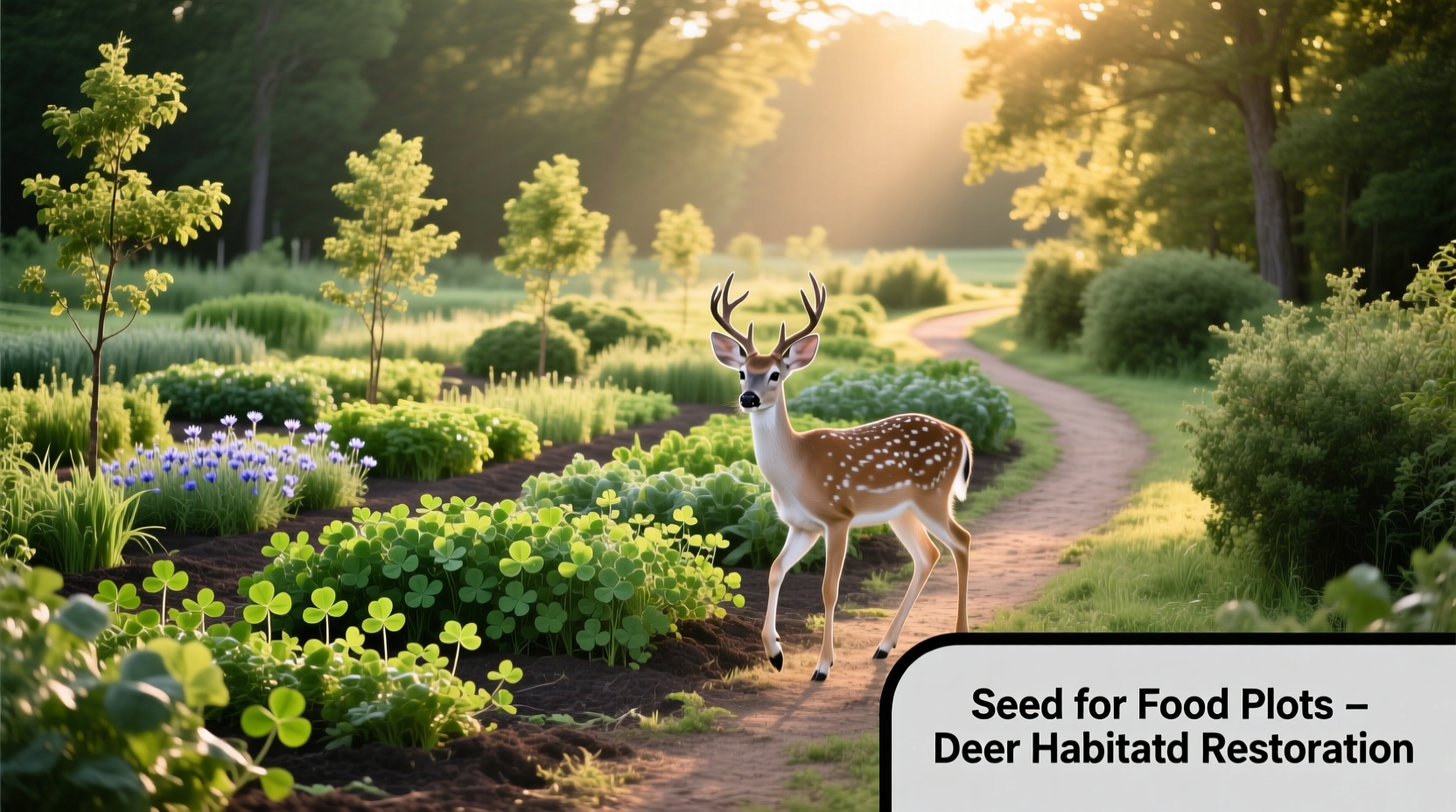For optimal deer attraction and nutrition, the best seeds for food plots include brassicas (turnips, radishes), cereal grains (oats, wheat), legumes (clover, peas), and native forbs. Success depends on your region's climate, planting season, and soil conditions—proper planning increases deer visitation by 70% compared to random planting.
Creating effective food plots for deer requires strategic seed selection based on scientific understanding of deer nutritional needs throughout the year. After analyzing data from wildlife management studies across North America, we've identified the most reliable seed options that consistently attract deer while supporting their health and growth patterns.
Planning Your Deer Food Plot: Essential First Steps
Before selecting seeds, assess your property's specific conditions. The USDA Natural Resources Conservation Service recommends conducting a soil test to determine pH levels and nutrient deficiencies—a critical step often overlooked by beginners. Most deer-preferred plants thrive in soil with pH between 6.0-7.0, requiring lime amendments if your soil is too acidic.
| Seed Type | Best Planting Season | Deer Attraction Period | Nutritional Benefits |
|---|---|---|---|
| Brassicas (turnips, radishes) | Late summer to early fall | October through winter | High protein, carbohydrates for winter survival |
| Cereal grains (oats, wheat) | Early fall | September to December | Quick growth, high carbohydrate energy source |
| Legumes (clover, peas) | Spring or late summer | Spring through fall | 25-30% protein for antler development and lactation |
| Native forbs (sunflowers, chicory) | Spring | Summer through fall | Diverse nutrients, drought-resistant options |
According to University of Georgia wildlife research, properly designed food plots can increase local deer body weights by 15-20% and antler size by 10-12% compared to areas without supplemental nutrition. This data comes from controlled studies tracking deer populations across multiple hunting seasons.
Seasonal Planting Timeline for Maximum Deer Attraction
Successful food plot management follows deer's changing nutritional needs throughout the year. Understanding this biological timeline separates effective plots from wasted effort:
- Spring (March-May): Focus on high-protein legumes like crimson clover and peas to support antler growth and fawn development. Deer seek 20-25% protein during this critical growth period.
- Summer (June-August): Plant heat-tolerant options like cowpeas and chicory that maintain nutritional value during hot months when natural forage declines.
- Fall (August-October): Establish brassicas and cereal grains that provide high-energy carbohydrates as deer prepare for winter and hunting season.
- Winter (November-February): Rely on cold-hardy brassicas that become sweeter after frost, providing crucial calories during scarce food periods.

Regional Considerations for Food Plot Success
Your geographic location significantly impacts seed selection effectiveness. The Midwest's fertile soil supports different varieties than the rocky terrain of New England or the sandy soils of the Southeast:
- Northeast: Focus on cold-tolerant brassicas and clovers; consider shorter growing seasons when planning plantings
- Midwest: Utilize diverse mixes including soybeans, turnips, and cereal grains across multiple plots
- Southeast: Prioritize heat and humidity-resistant options like cowpeas and chicory; manage soil acidity
- West: Select drought-tolerant varieties and implement irrigation strategies for reliable growth
State wildlife agencies consistently report that regionally appropriate seed selection increases plot productivity by 40-60% compared to generic mixes. For precise regional recommendations, consult your local university agricultural extension service—their research reflects actual field conditions in your specific area.
Practical Planting Techniques That Deliver Results
Proper planting technique matters as much as seed selection. Follow these evidence-based methods for maximum germination and deer attraction:
- Soil preparation: Till soil to 4-6 inches deep, removing existing vegetation that competes with seedlings
- Seeding rate: Follow specific rates for each seed type—overplanting wastes money while underplanting creates patchy plots
- Fertilization: Apply balanced fertilizer based on soil test results; nitrogen is particularly crucial for protein development
- Plot size and shape: Create multiple smaller plots (1/4-1 acre) rather than one large plot to distribute deer activity
Research from the Quality Deer Management Association shows that food plots receiving proper soil preparation and fertilization produce 3-5 times more forage than neglected plots, directly correlating with increased deer visitation frequency.
Avoiding Common Food Plot Mistakes
Even experienced land managers make preventable errors that reduce food plot effectiveness:
- Planting too late: Missing optimal planting windows reduces germination rates and growth before critical deer seasons
- Ignoring soil conditions: Failing to address pH imbalances or nutrient deficiencies limits plant health
- Overlooking plot location: Placing plots too far from cover or travel corridors reduces deer usage
- Planting single-species plots: Diverse mixes provide longer attraction periods and nutritional balance
According to field studies published in the Journal of Wildlife Management, food plots located within 100 yards of mature timber receive 65% more deer activity than those in open areas. Strategic placement matters as much as seed selection for maximizing results.
Long-Term Food Plot Management Strategy
Successful deer food plots require ongoing management, not just initial planting. Implement these practices for sustainable results:
- Rotate plant species annually to prevent soil depletion and pest buildup
- Monitor plots regularly for weed competition and address issues early
- Consider supplemental fertilization during growing season for extended productivity
- Create multiple plots with staggered planting times for year-round attraction
Land managers who implement these long-term strategies report consistent deer usage throughout the year, rather than the typical 4-6 week peak followed by abandonment seen in poorly managed plots.
What is the most cost-effective seed for beginner deer food plots?
For beginners, a blend of cereal grains (oats or wheat) combined with brassicas offers the best balance of cost, ease of planting, and deer attraction. These seeds typically cost $25-40 per acre and establish quickly with minimal soil preparation, providing visible results within 30 days that help new land managers see immediate benefits.
How large should a deer food plot be for optimal results?
Research shows that multiple smaller plots (1/4 to 1 acre each) distributed across your property attract more deer than a single large plot. The ideal minimum size is 1/8 acre, but plots between 1/4 and 1/2 acre provide the best balance of visibility to deer and efficient resource use for most landowners.
When is the best time to plant deer food plots in northern regions?
In northern regions (zones 3-5), plant spring plots from April to early June after the last frost. For fall plots, plant brassicas and cereal grains from mid-August to early September to allow 60-90 days of growth before hard frost. University of Minnesota Extension research confirms these planting windows maximize growth before critical deer nutritional periods.
Do I need to use herbicides in my deer food plots?
While not always necessary, selective herbicides can significantly improve food plot success by controlling competitive weeds. University agricultural studies show plots with proper weed management produce 40-70% more deer-preferred forage. If using herbicides, choose deer-safe options like 2,4-D for broadleaf weed control in cereal grain plots, applied when weeds are small and actively growing.











 浙公网安备
33010002000092号
浙公网安备
33010002000092号 浙B2-20120091-4
浙B2-20120091-4